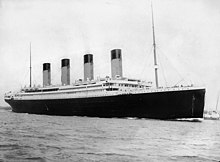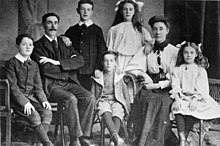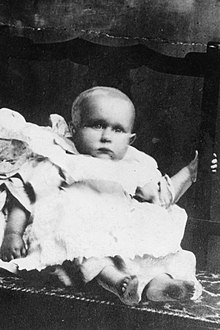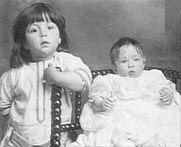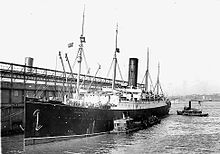Passengers of the Titanic
A total of 2,240 people sailed on the maiden voyage of the RMS Titanic, the second of the White Star Line's Olympic-class ocean liners, from Southampton, England, to New York City.
[1] Partway through the voyage, the ship struck an iceberg and sank in the early morning of 15 April 1912, resulting in the deaths of 1,510 passengers and crew.
Lord Pirrie, chairman of Harland and Wolff, intended to travel aboard the Titanic, but illness prevented him from joining the ill-fated voyage; however, White Star Line's managing director J. Bruce Ismay and the ship's Harland and Wolff designer, Thomas Andrews, were both on board to oversee the ship's progress on her maiden voyage.
[9] Some of the most prominent members of the American social elite made the trip: 47-year-old real estate builder, businessman, and multimillionaire Colonel John Jacob Astor IV and his 18-year-old pregnant wife Madeleine were returning to the United States for their child's birth.
Among others were industrialist magnate and millionaire Benjamin Guggenheim; Macy's department store owner, and former member of the United States House of Representatives Isidor Straus, and his wife Ida; George Dennick Wick, founder and president of Youngstown Sheet and Tube Company; millionaire streetcar magnate George Dunton Widener; John B. Thayer, vice president of Pennsylvania Railroad, and his wife, Marian; Charles Hays, president of Canada's Grand Trunk Railway; William Ernest Carter and his wife, American socialite Lucile Carter; millionaire, philanthropist and women's rights activist Margaret Brown; tennis star and banker Karl Behr; famous American silent film actress Dorothy Gibson; prominent Buffalo architect Edward Austin Kent; and President William Howard Taft's military aide, Major Archibald Butt, who was returning to resume his duties after a six-week trip to Europe.
Swedish first class passenger and businessman Mauritz Håkan Björnström-Steffansson owned the most highly valued single object on board: a masterpiece of French neoclassical painting entitled La Circassienne au Bain, for which he would later claim US$100,000 in compensation (equivalent to US$3.1 million in 2023).
[13] Second-class passengers were leisure tourists, academics, members of the clergy, and middle-class English, Scottish and American families.
The ship's musicians travelled in second-class accommodations; they were not counted as members of the crew, but were employed by an agency under contract to the White Star Line.
[7] Twelve-year-old Ruth Becker passed the time by pushing her two-year-old brother Richard around the enclosed promenade in a stroller provided by the White Star Line.
John Harper, a well-known Baptist pastor from Scotland, was travelling to the United States with his daughter and sister to preach at the Moody Church in Chicago.
[20] Schoolteacher Lawrence Beesley, a science master at Dulwich College, spent much of his time aboard the ship in the library.
[21] The Laroche family, father Joseph and daughters Simonne and Louise, were the only known passengers of black ancestry on board the ship.
Joseph hoped that a move from their former home in Paris back to Haiti, where his uncle Cincinnatus Leconte was president, would take his family away from racial discrimination.
Michel Sr. died in the sinking and photographs of the boys were circulated throughout the world in the hopes that their mother or another relative could identify the French toddlers, who became known as the "Titanic Orphans".
[24] After arriving in New York, the children were cared for by Titanic survivor Margaret Hays until their mother, Marcelle Navratil travelled from Nice, France, to claim them.
In addition to large numbers of British, Irish, and Scandinavian immigrants, other passengers were from Central and Eastern Europe, the Levant (Greater Syria), and Hong Kong.
In 2007, scientists using DNA analysis identified the body of a small, fair-haired toddler, one of the first victims to be recovered by the CS Mackay Bennett, as Frederick and Augusta's youngest child, 19-month-old Sidney.
Nine-year-old Frank Goldsmith recalled peering into the engine room and climbing up the baggage cranes on the poop deck.
The Titanic was fitted with grilles to prevent the classes from mingling and these gates were normally kept closed, although the stewards could open them in the event of an emergency.
[38] Fang settled in US, and fellow survivor Lee Bing moved to Canada living in Galt, Ontario, working at White Rose Cafe, then Toronto, and disappeared, having left for China.
[46][8] In 1997, Ray Hanania, a Palestinian American journalist, watched the Titanic (1997) film and noticed some background characters saying yalla, meaning "hurry" in Arabic.
At least two crew members were also Jewish: barber Herbert Klein and "Hebrew cook" Charles Kennel; neither survived the sinking.
[49] Jewish passengers were in every class and represented a variety of nationalities, including Poland, England, the United States and the Russian Empire.
[50][51] On the night of 14 April 1912, around 11:40 pm, while the Titanic was sailing about 400 mi (640 km) south of the Grand Banks of Newfoundland, the ship struck an iceberg and began to sink.
The closest ship to respond was Cunard Line's Carpathia 58 mi (93 km) away, which would arrive in an estimated 4 hours—too late to rescue all of Titanic's passengers.
The White Star Line chartered the cable ship Mackay-Bennett from Halifax, Nova Scotia, to retrieve bodies.
The physical appearance of each body—height, weight, age, hair and eye colour, visible birthmarks, scars or tattoos, was catalogued and any personal effects on the bodies were gathered and placed in small canvas bags corresponding to their number.
[60] Captain Larnder of the Mackay-Bennett and the undertakers aboard decided to preserve all bodies of first-class passengers because of the need to visually identify wealthy men to resolve any disputes over large estates.
[citation needed] 190 bodies recovered were preserved and taken to Halifax, Nova Scotia, the closest city to the sinking with direct rail and steamship connections.
